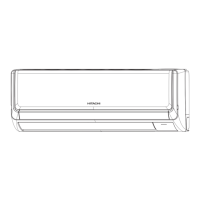
Do you have a question about the Hitachi RAS-12-HNCE and is the answer not in the manual?
| Cooling Capacity | 3.5 kW |
|---|---|
| Heating Capacity | 4.0 kW |
| Power Consumption (Cooling) | 1090 W |
| Refrigerant | R410A |
| Power Supply | 220-240V, 50Hz |
| Indoor Unit Weight | 9 kg |
| Type | Split |
| Dimensions (Outdoor Unit) | 780 x 540 x 260 mm |
| Outdoor Unit Dimensions (W x H x D) | 780 x 540 x 260 mm |
| Energy Efficiency Ratio (EER) | 3.21 |
Covers general notes, introduction, and environmental aspects of the UTOPIA series.
Details applied symbols, DANGER/CAUTION/NOTE messages, and norms/regulations.
Classifies outdoor and indoor unit models and lists accessories.
Outlines DANGER/CAUTION points for unit installation to prevent hazards.
Provides hanging methods, caution notes, and gross weight details for safe transport.
Specifies hanging methods and center of gravity for various models.
Details basic dimensions and clearance requirements for unit installation.
Covers concrete foundation, metal plates, and wall fixing requirements for outdoor units.
Describes installation of optional accessories like air flow guides and snow protection hoods.
Covers piping materials, principles, suspension, and brazing work for refrigerant piping.
Details connecting refrigerant pipes to outdoor units for various models.
Outlines piping length, header/line branch systems, and combinations for different units.
Explains procedures for charging refrigerant, including cautions and quantities.
Addresses HFC concentration, calculation, and countermeasures for refrigerant leakage.
Details procedures for using existing pipes, renewal kits, and compatibility with older refrigerants.
Provides general safety notes and checks for electrical wiring work, including EMC compliance.
Illustrates correct power source and transmission wiring connections for various outdoor units.
Explains DIP switch settings for test run, pipe length, capacity, and refrigerant cycle number.
Discusses wiring between indoor and outdoor units, wire sizes, and main switch protection.
Details features, specifications, DIP switch settings, and connection examples for the H-LINK II system.
Provides detailed wiring diagrams for different model series and power supplies.
Explains control subjects, purpose, and operation modes for compressor, valves, and fans.
Details connector indications, switch indications, and LED indications for various outdoor unit PCBs.
Covers compressor protection devices and safety/control device settings for outdoor units.
Illustrates operational sequences for cooling, dry, heating, automatic, and defrost operations.
Explains freezing protection, high pressure prevention, discharge gas temperature control, and preheating.
Details available ports, optional signals, and connection examples for input/output signals.
Explains setting and description of optional functions configurable via the 7-segment display.
Lists optional functions configurable via the remote control switch, with individual settings.
Outlines essential checks before starting the test run, including safety and wiring.
Step-by-step guide for performing test run using the PC-ART remote control.
Step-by-step guide for performing test run using the PC-ARF remote control.
Procedure for test run using a wireless remote control switch.
Details how to perform a test run directly from the outdoor unit.
Provides checklists for test run and compressor checks for verification.
Covers basic checks using the 7-segment display, power supply failures, and transmission abnormalities.
Explains how to interpret alarm displays and use alarm codes for diagnosis.
Guides on using remote controllers (PC-ART, PC-ARF) and 7-segment display for troubleshooting.
Details checks for key components like DIP-IPM inverter, capacitors, fan motors, and expansion valves.
Lists cycle, structural, electrical parts, and parts names for RAS-(2-2.5)HVNP models.
Lists cycle, structural parts, and parts table for RAS-3HVNC models.
Lists cycle, structural, electrical parts, and parts names for RAS-3HVNPE models.
Lists cycle, structural, electrical parts, and parts names for RAS-(4-6)H(V)NPE models.
Lists cycle, structural, electrical parts, and parts names for RAS-(4-6)H(V)NCE models.
Lists cycle, structural, electrical parts, and parts names for RAS-(8-10)HN(P/C)E models.
Lists cycle, structural, electrical parts, and parts names for RAS-13HN(P/C) models.
Provides a general introduction to servicing procedures and safety precautions.
Details servicing steps for removing components like pipe cover, front cover, fan, and compressor.
Covers servicing procedures for specific Premium series outdoor units (RAS-3HVNPE, etc.).
Covers servicing procedures for specific Standard series outdoor units (RAS-(4-6)H(V)NCE, etc.).
Details inverter specifications, time chart, protective functions, and overload control.
Explains thermistors for outdoor units and their characteristics, especially for compressor protection.
Describes the electronic expansion valve, its components, and checking procedures.
Details high pressure switches and pressure sensors for protection control.
Provides specifications and circuit diagrams for noise filters used with inverters.
Specifies the use and electrical characteristics of capacitors CB1 and CB2.
Lists specifications and purpose of reactors (DCL) for 3-phase and 1-phase power.
Explains the reliable mechanism for low vibration and sound, and the principle of compression.
Covers checks for power source, wiring, compressor burnout, insufficient cooling, and abnormal sounds.
Outlines maintenance tasks for indoor and outdoor units, including fan motors, heat exchangers, and electrical equipment.
Provides a template for recording service and maintenance activities.
Details how to record service data using the 7-segment display.
Provides a data sheet for recording service and maintenance by remote control.
Describes the procedure for pump-down when replacing the compressor.












